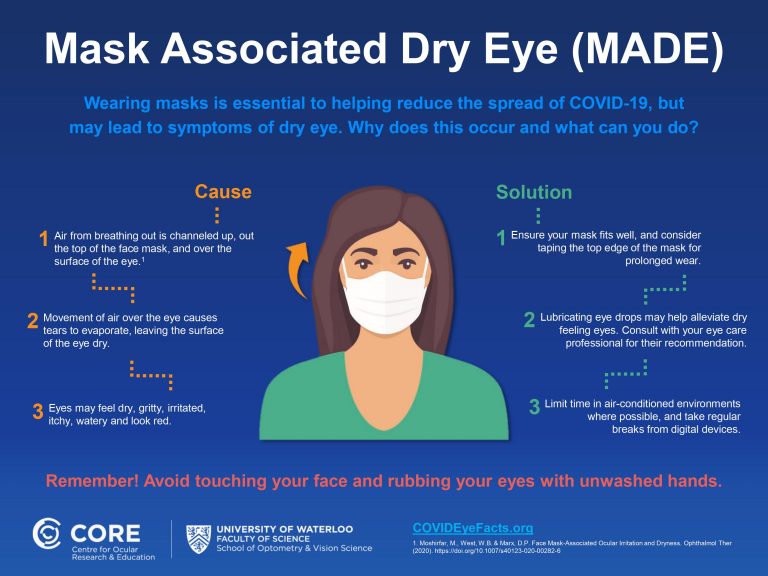
The use of face masks has been determined over the months of the pandemic to be essential to slow down the spread of the coronavirus that causes COVID-19. As with any change in behavior, though, there are unanticipated impacts. In this case, when a loosely worn mask redirects your breath upwards past your eyes, it can cause tears to evaporate more quickly. This leads to a new phenomenon: Increased reports of “dry eyes” to eye care professionals (ECPs).
The Centre for Ocular Research & Education (CORE) at the University of Waterloo in Canada are advising ECPs and dry eye sufferers on how to recognize what is now called “mask-associated dry eye” or MADE. And CORE is sharing methods to mitigate the causes and symptoms.
“Face masks are crucial in the fight against COVID-19, and ECPs are well-positioned to provide patients with advice on appropriate wear in order to maximize eye comfort,” said Dr. Lyndon Jones, director of CORE. “Asking patients about their mask-wearing experiences and providing a few helpful tips takes little time and can make a substantial difference.”
MADE: What is it and who may get it?
Per CORE, here is a description of mask-associated dry eye:
“Masks significantly reduce the outward spread of air. However, exhaled air still needs to disperse; when a mask sits loosely against the face the likely route is upwards. This forces a stream of air over the surface of the eye, creating conditions that accelerate tear film evaporation, leading to dry spots on the ocular surface and discomfort.
“In addition to worsening symptoms in patients with pre-existing dry eye disease, MADE can affect a wide-spectrum of others: the elderly who typically have a poorer quality tear film, contact lens wearers, and masked people working extended hours in air-conditioned settings and/or while using digital screens.”
As EyeGiene team members are Dry Eye Disease treatment specialists, we know that the extended screen time from sheltering-in-place and working at home does increase the incidence of Dry Eye Disease symptoms. So the use of face masks is just adding to this trend.
What Steps to Take to Relieve MADE Symptoms
CORE suggests a number of MADE-related actions to take:
- For ECPs, make it routine to consider the role of the face mask if there are worsening symptoms and signs in patients with confirmed dry eye disease, or if patients report dry, uncomfortable eyes or variable vision for the first time. Ask all patients how their eyes feel while wearing a mask. Most patients will not think to associate their symptoms with mask use.
Tips for Patients
As illustrated in CORE’s MADE infographic (to be attached to the article), we recommend that face mask wearers experiencing dry eye symptoms try a few simple solutions:
- Ensure that a mask is worn appropriately, particularly with spectacles or sunglasses. A carefully taped top edge that does not interfere with blinking may help.
- Apply lubricating drops, asking your Eye Care Practitioner for recommendations.
- Limit time in air-conditioned environments and take regular breaks from digital devices.
- CORE experts are also been quick to state that people should first check with their ECP for advice and to rule out other cases—a good approach with any new eye-related concern.
EyeGiene Can Help
- Use EyeGiene’s dry heat eye compresses to ensure the eyelids’ Meibomian Glands continue to produce the natural oils that help prevent excessive tear evaporation.
Keep Wearing the Face Masks!
The increasing incidence of MADE should not be used as an excuse to stop wearing face masks. As Dr. Jones of CORE states:
“Responsibly wearing a mask, even when having to contend with eye dryness, is a critical part of overcoming the global pandemic. The good news is that we understand MADE and can address it—an opportunity for ECPs to further communicate their knowledge and ongoing value to patients at a time when sound, scientific guidance is needed more than ever.”
